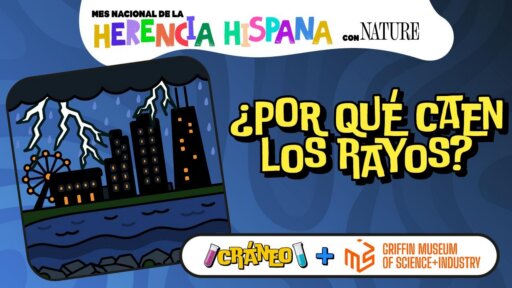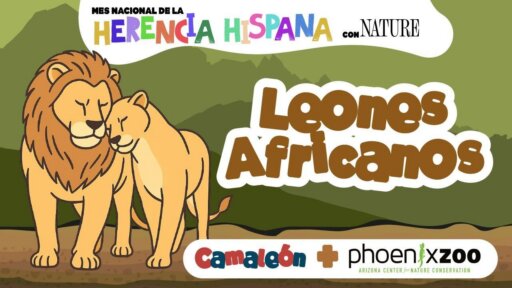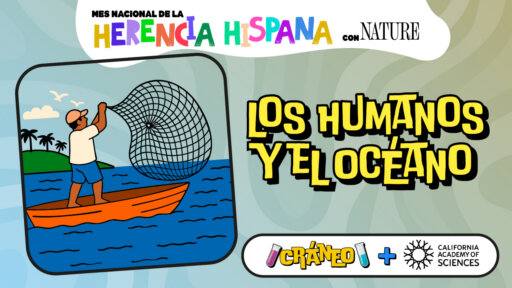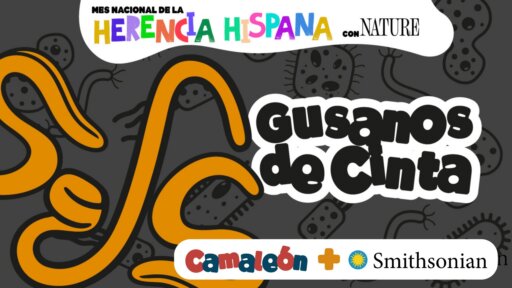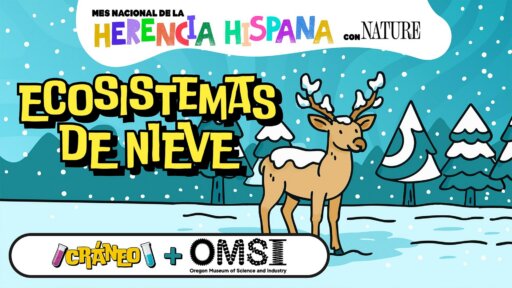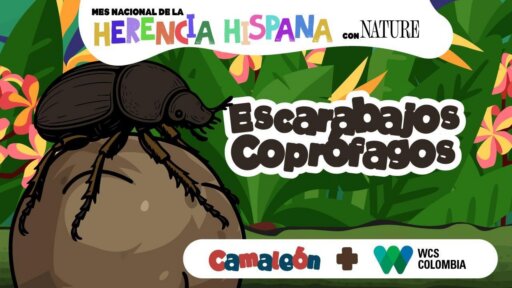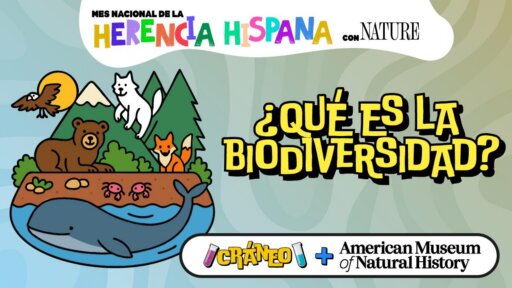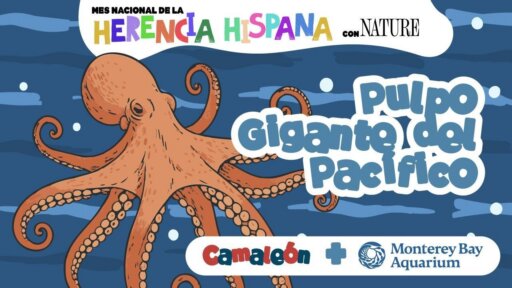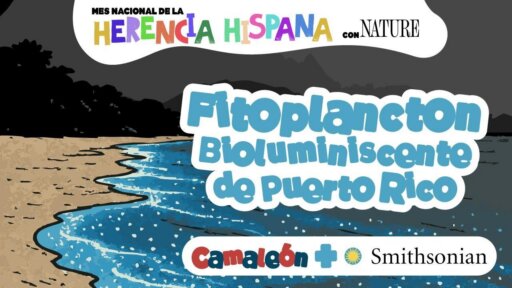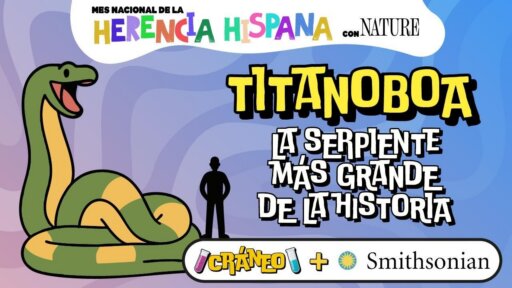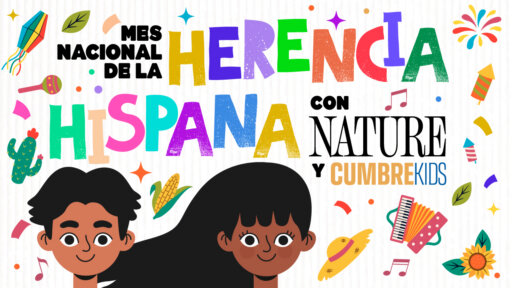TRANSCRIPT
Robert 00:00
This episode of orbit Science for Kids On The Move is produced thanks to the amazing team at PBS nature. It’s part of a bilingual podcast series for National Hispanic Heritage Month between PBS nature and our team at Cumbre kits.
Robert 00:13
What is up, Orbiters? We have a fascinating episode for you today, but let’s start out engaging that super creative imagination of yours. Look at your arms and legs. Now, imagine you have eight arms and legs. Now imagine they’re red. Now imagine they’re changing colors. Now imagine they’re covered in suction cups. Now imagine they all have their own brains. Now wave them around like you’re a Giant Pacific Octopus.
Robert 01:00
We’re going to learn a ton today with our friend René from the Monterey Bay Aquarium.
Rene Carbajal 01:07
My name is René Carbajal and I am a marine biologist.
Robert 01:10
Do you think René can answer some really tricky questions,
Children 01:13
How smart is an octopus? How are baby occupy born? What do octopuses eat? And how do they hunt?
Robert 01:23
We won’t know until we dive in! Grab your snorkels and swim trunks. Here we go.
Robert 01:29
Welcome to a new episode. I am here, joined by the one, the only, the special, the intelligent Milam Howard! Milam saying hello to our listeners.
Milam 01:49
Hi
Robert 01:49
Hi Mr. Milam. Where are you joining us from today?
Milam 01:54
Houston, Texas.
Robert 01:56
Then your dad’s office. It looks like, Well, hey, Milam, what’s going what’s going on in life right now?
Milam 02:03
Um, I’m excited that football season is starting.
Robert 02:07
We are recording on August 11, so we are about to get ready for American football season. Why are you excited? Are you a football fan?
Milam 02:16
Yeah, pre season in the NFL is already happening.
Robert 02:20
It’s already happening. And who are your favorite teams that you’re excited about?
Milam 02:26
Bengals, Vikings and Buccaneers.
Robert 02:29
That’s an it’s an interesting choice, the Bengals, the Buccaneers and and the Vikings. And what are you excited about? Why are you excited about football season?
Milam 02:38
Because it’s my favorite sport.
Robert 02:39
Yeah, what do you like about it?
Milam 02:43
I don’t know. I just do.
Robert 02:44
You just do. You know sometimes, sometimes we just like things. We don’t exactly know why we like them. We just like them.
Milam 02:50
I just like whenever they just play each other.
Robert 02:55
Yeah. Have you ever been to a football game? Milam?
Milam 02:57
Yes.
Robert 02:59
What was that like?
Milam 03:01
It was very, very, very, very, very, very, very, very, very loud.
Robert 03:09
Wow. That is, that is incredibly loud, Milam. I cannot imagine how loud that would be. Well, hey, Milam, you want to, you want to play a game?
Milam 03:20
Yes
Robert 03:21
Well, this game is called Quick Draw story. Have you ever played this game before?
Milam 03:26
No
Robert 03:28
No, okay, this is a new one. It’ll be a new one for our listening families too, I bet. So basically, what we’re gonna do is one person will name an object. They’ll say like purple dinosaur or flying toaster. And
Milam 03:42
I see both of these on here.
Robert 03:44
You’ve got a cheat sheet, and the other person will have to make up a short story about it on the spot. Does that make sense? Milam, are you ready to go?
Milam 03:54
Yes.
Robert 03:54
Okay, let’s start with a flying pancake. Yeah, all right, go.
Milam 04:05
Once upon a time, there’s this flying pancake, and it got eaten by a bird. The end.
Robert 04:11
The end a bird. What kind of a bird ate it?
Milam 04:14
Hawk
Robert 04:14
A hawk? Wow. And so normally, the hawk would probably eat like a squirrel, but in this case, it was like flying pancake. I’m going after that,
Milam 04:25
Yep. Okay, I love it. All right. Do you have an object you want me to tell a story about
Milam 04:33
A pineapple in sunglasses, driving a convertible.
Robert 04:38
Wow. Okay, a pineapple and sunglasses, driving a convertible. Okay, so once upon a time, we were in Miami, Florida, and it was a pretty day outside, and so Pina the pineapple decided that they wanted to go on a ride along the beach. Of course, because it was so sunny, they put on their sunglasses, and guess what? They saw a red tailed hawk eating a flying pancake right next to the beach.
Milam 05:14
The end.
Robert 05:15
You ready for your next one? Yeah. Okay. This one is a rock
Milam 05:21
that sings opera.
Robert 05:26
Yep
Milam 05:27
Once upon a time, there was a rock that singed opera. Then he was then he was jealous about a paper that was singing opera better. The end,
Robert 05:37
the end. Were there scissors? Anywhere involved in your story?
Milam 05:42
No, the scissors sing too low. So he, so they weren’t invited.
Robert 05:48
They weren’t invited. So we were in Rock Paper Scissors world. Okay, your turn.
Milam 05:53
A snail who wants to run track.
Robert 05:58
a snail that wants to run track. Okay, once upon a time, there was a snail that wanted to run track, but the snail went to school with a lot of rabbits and cheetahs, and it was very sad. However, the snail that wanted to run track found another snail that also wanted to run track and a slug that wanted to throw a shot put, and so the three of them started their own snail slug track team. The end. What’d you think would you join? Would you race against a snail?
Milam 06:31
Yes, that’s an easy one..
Robert 06:34
You ready for the last one? The stinkiest sock in the world.
Milam 06:40
Once upon a time, there was a stinky sock there. The stinkiest sock in the world snuck into someone’s sock, bigger that he put the body that school. No one wanted to play with him. The end.
Robert 06:54
The end. I think, I think wearing clean socks probably would make it easier to make friends. Well, Milam, we have done it. Congratulations. What do you think, Milam?
Milam 07:08
I am a robot now.
Robert 07:11
Okay, Milam is converted into a robot. Well, we have, we have finished that game. And if families want to play it, you just come up with a silly object, and then on the spot, you have to come up with a story to practice your imagination. How about you know what we’re what episode we’re talking about today, Mr. Milam?
Milam 07:31
Giant Pacific Octopus.
Robert 07:33
Giant Pacific Octopus. Okay, well, we are going to be joined today by René from the Monterey Bay Aquarium.
Milam 07:45
Hi René. Welcome to the podcast. What do you do for work?
Rene Carbajal 07:47
My name is René Carbajal and I am a marine biologist, a scientist that works with the marine life at the Monterey Aquarium. We’re located in the central coast of California in a marine sanctuary. Our mission is super important to inspire the conservation of the ocean. My job is to take care of the ocean animals and plants that live in our aquarium.
Milam 08:10
What were you like as a kid?
Rene Carbajal 08:12
I have been in love with the water since I was very tiny. My parents always say I learned to swim before I could even walk. So I’m a water creature. Really. I’ve been fascinated by the ocean since a kid.
Robert 08:25
Milam, are you ready to learn with René,
Milam 08:28
Yes
Robert 08:28
Let’s do it. Hey. Adults want to participate in future episodes of orbit? Just visit www.cumbrekids.org/questions and fill out a short form. We’ll add you to our WhatsApp community so you can submit your kids questions for future episodes. We’ll leave the link in the description of this episode. You can also submit questions for our podcasts in Spanish, Craneo, ciencia para Ninos Curiosos and Camaleon, animales para ninos curiosos. Okay, let’s get back to René.
Hey, René, I have a really super, mega important question before we go any further. If I want to talk about more than one octopus, do I say look over there at those octopuses, or look over there at those octopi or octopods or something else?
Rene Carbajal 09:29
That’s a great question. Let’s clear up the octopus mystery. Octopuses is the most commonly accepted and correct English plural. I think a good way to remember maybe, and a fun one will be that is one octopus, two octopuses, and never octopi.
Robert 09:48
Okay, so I see one octopus in the water. I had a dream about two octopuses last night, and never have I ever seen octopi. Hey, René. If I were swimming in the ocean and I saw a Giant Pacific Octopus, what would it look like?
Rene Carbajal 10:05
The Giant Pacific Octopus is an amazing animal. It looks like it’s for another planet because it’s shape and all the special things it can do. It is the smartest invertebrate in the world. That means it has no bones his organs, like stomach and the heart, they’re all inside his head. And one of the craziest parts too is it has nine brains. It has three hearts, and his eight arms are all covered in Super strong, sensitive suction cups. They can smell and taste with their arms. It’s almost like having a bunch of tiny little noses and tongues all over your arms.
Robert 10:45
Wait a second, this cannot be a real animal. You’re saying this animal has no bones, nine brains, three hearts and suction cups all over its eight arms, so it can taste and smell with its arms. Surely, that’s like all of the cool things, right?
Rene Carbajal 11:04
René, it has a tube called the siphon, which is like a hose that uses to shoot at ink to escape predators or to swim away through the water like a rocket
Robert 11:16
All that, and a special tube that can shoot ink at predators. That’s kind of like if you were walking around with a straw in your mouth that you shoot paint out of whenever somebody makes you angry.
Rene Carbajal 11:27
It has these big eyes that can sense color in the environment, even though they can only see black and white, and yes, it even has a beak like a parrot. It uses to bite and paralyze the prey with venom.
Robert 11:40
Okay, I’m starting to think this is actually an alien. Just to recap, no bones, nine brains, three hearts, suction cups, a siphon to spit ink. Really big eyes, but they can’t see color for some reason. A beak like a parrot. And give it some venom, okay? René, this is definitely all the cool stuff about it, right?
Rene Carbajal 12:02
One of the coolest things about octopuses, to me is the camouflage. It can change color and texture and shape just in a fraction of a second. I called the marine chameleon.
Robert 12:15
It even has a camouflage superpower that lets it blend in with its surroundings instantly. Wow. Okay, let’s go to the next question.
Loretta 12:25
Hi. My name is Loretta. I am six. My question is, how big can the giant specific octopus be
Robert 12:39
Great question Loretta, to answer this, first, I need you to hold your arms out wide. Hold them out as wide as you can. The distance from the tips of your fingers on one side to the tips of your fingers on the other side is called your arm span. An adult human like me, or maybe your parents or your teacher, has an average arm span of around five and a half feet, or almost two meters. What about the arm span of the Giant Pacific Octopus? Shout out your guess. I’ll give you a couple seconds.
An average Giant Pacific Octopus has arms that reach 14 feet, or more than four meters. That’s like three full grown adults stacked on top of each other. Rene says that his aquarium had an octopus that weighed 130 pounds, or about as much as a human being.
Rene Carbajal 13:42
And imagine the biggest one recorded was 600 pounds and 30 feet long. Just imagine it’s as long as a truck, probably
Robert 13:55
An octopus, the size of a truck. Whoa.
Hey, let’s take a moment for our mystery sound of the day. We’ll play a sound, and you guess what it is. I’ll play the sound three times. This is a great moment to stretch your arms and legs, maybe even jump up and down a few times. Here’s the mystery sound.
Think you have it?
Okay, one last time.
Okay, get your guess. We’ll tell you the answer at the end of the episode. Hey, René, where do Giant Pacific octopuses live?
Rene Carbajal 14:37
It’s in the Northern Pacific Oceans, in places like Japan, Russia, Alaska and the West Coast of the United States, it can lift a depth up to five 1500 meters. That’s almost like 5000 feet. So to put it in perspective, it’s like a stack of five Eiffel Towers on top of each other,
Robert 15:01
Five Eiffel Towers? If you don’t know what the Eiffel Tower is, think of five skyscrapers in a big city on top of each other, but going from the ocean surface down to the sea floor. So the Giant Pacific Octopus can live in very deep water!
Rene Carbajal 15:21
But it can also live in shallow water, close to the shore, and it can even come out of the water. It can be out of water for good 20-30, minutes, and even longer, as long as it keeps its gills wet while moving from one tide pool to the other. It likes to live in caves on dark places where it feels safe, but also comes around and explore and hunt near his territory.
Milam 15:46
My name is Milam, and I’m seven years old, and I live in Houston, Texas. Here’s my question, do octopuses have arms or tentacles? And what is the difference?
Rene Carbajal 15:57
That’s a great question, Milam. A lot of people think octopuses have tentacles. I used to think that too, but actually the correct word is arms. An arm has suckers all along its leg, and a tentacle only has suckers at the tip of the arm, and it’s a little bit wider at that part of the arm too.
Robert 16:19
Well, that’s cool. I kind of wish I had suckers.
Jahaziel 16:22
Hi, friends. My name is Jahaziel. My question is, how the octopus get a black ink?
Robert 16:31
Yeah, I want to know that too. Where does their black ink come from?
Rene Carbajal 16:37
Octopuses have a special ink sack inside of their bodies. They are located near the digestive system, and it’s close to the stomach. When they feel scared or threatened, they squeeze the ink sac and they shoot out dark cloud of ink throughout the tube called the siphon. It’s like throwing a smoke bomb and vanishing like a ninja.
Wells 17:00
My name is Wells. I’m from Houston. I’m five years old. I live in Houston, Texas. And my question is, what do octopuses eat? And how do they hunt?
Rene Carbajal 17:14
Thanks, Wells, for the question. Well, Giant Pacific octopuses are meat eaters. That means that they like to eat animals, and their favorite food includes crabs, shrimp, squid, fish and sometimes even other octopuses. They’re super sneaky hunters. They have a very sharp beak like a parrot to bite and squirt out venom to stop the food from moving, and then they use a special tongue with a tiny teeth called the radula to scrape out all the yummy parts.
Robert 17:48
Okay, a lot of us want to know about octopus babies.
Loretta, Kenji, Luna 17:53
Hi, my name is Loretta. How many babies can a mother octopus have?.
My name is Kenji. I live in Pasadena, California. I’m five years old, and my question is, how are baby occupy born?
Hi, my name is Luna. I’m five years old. I live in New York, and my question is, how do the Giant Pacific Octopus reproduce
Rene Carbajal 18:28
That’s a great question. Luna Kenji and Loretta. A female can lay over 80,000 tiny eggs, each one about the size of a grain of rice, and once she lays them, she becomes a full time mama. She never leaves the eggs, not even to eat, protecting them from predators, cleaning them with her arms and suction cups. She pretty much sacrifices everything for her babies, even her own life. And when the tiny octopuses finally hatched, she passes away, but thanks to her love for and dedication for the babies, thousands of tiny octopuses swim off into the ocean.
Robert 19:16
The mama octopus loves her babies so much that she sacrifices her life protecting and caring for her eggs. You know, sometimes I learn about things in nature that are hard to understand and make me feel sad. It’s okay if you feel sad, too. When I learned about mama octopuses, I also felt admiration. Do you know what that word means, admiration? It means I feel inspired by the example of mom octopuses and how much they sacrifice for their babies. It makes me want to do a better job taking care of the environment so that baby octopuses have a safe place to live. It also makes me want to be a more loving person for the people around me too. This might be a good moment to pause the episode and talk with your mom or dad or a trusted adult or maybe a friend about how it makes you feel.
Damika 20:15
Hello, My name is Damika. I am eight years old. I live in Venezuela, and my question is, how smart is an octopus? Thank you.
Diego 20:30
My name is Diego. I’m from Sierra and Mexico. My question is, why they are so smart?
Rene Carbajal 20:39
Thank you, Damika and Diego, they’re so smart, they can even recognize familiar human faces. They have a very special vision, similar to some fish and invertebrates, and they can remember who you are just by your face.
Robert 20:53
Hey, kids, do you remember how many brains a Giant Pacific Octopus has? Hold up that number of fingers, a Giant Pacific Octopus has nine brains.
Martin and Mario 21:07
Hello. My name is Martin. I’m from Chile. I’m seven. And my question is, why does the giant octopus use so many brains. Hello, I am with Mario. What are the nine brains of an octopus? Four Bye, bye.
Rene Carbajal 21:32
They have one main brain in their head, just like we do, but they also have many brains, one in each arm. It helps each arm to think and move on its own, really. For example, if one arm touches something, it can analyze it instantly without even asking the main brain what to do.
Robert 21:54
Well, that is cool. It’s like if my hand could think about what’s for dinner, while my foot thinks about a math lesson, and my elbow thinks about my favorite baseball team, and my other elbow wonders if towels ever get dizzy when they’re in the dryer.
Rene Carbajal 22:12
And Pacific octopuses are super flexible and can move their whole body independently. For example, an octopus eyes can move and rotate independently, almost like a chameleon, looking in two different directions at the same time.
Robert 22:31
Wow Milam, that was super interesting. Are you ready to take a little break?
Milam 22:37
Yes.
Robert 22:38
Well, why don’t we move around a little bit. I want you to help us out with that. I need three things from you. I need you to tell me a body part. I need you to tell me what shape, and I need you to tell me like an adjective or how we should do something. Okay, so can you tell us? Tell us what is a body part today?
Milam 22:59
My fingers
Robert 23:01
Your fingers, okay? And what is the shape that we want to make
Milam 23:06
Diamond
Robert 23:07
We want to make the shape of a diamond. And how should we make the shape of a diamond?
Milam 23:12
While hopping on one foot.
Robert 23:14
Okay, perfect. All right, so we’re going to take a few seconds, we’re going to make the shape of a diamond, and we’re gonna hop on one foot. Or if you’re seated in a car, you can just make the shape of a diamond and imagine that you’re hopping on one foot.
We learned today that the Giant Pacific Octopus is like a real life alien. It has no bones, nine brains, three hearts and arms covered in suckers that can taste and smell. It can squirt out dark ink through a special tube called a siphon to confuse predators. It also has a beak like a parrot, but with venom to catch its favorite foods, like crabs and fish. These octopuses can grow as big as a truck. They live super deep in the ocean and even change their color and texture to hide, kind of like an underwater chameleon. A mother octopus is a true hero. She lays 10s of 1000s of eggs and protects them until they hatch, even giving up her life to keep them safe. Hey, René, we have one more question that I think is super duper important.
Ygritte 24:26
Hello, my name is Ygritte Mostavo. I am nine years old. I live in Santa Cruz, Bolivia, and my question is, how can I help octopus to live more? Thank you.
Rene Carbajal 24:42
Thank you. Ygritte, I love these questions. Well, it turns out that all ocean animals, including our octopus friends, are in danger. And why? Because they face big problems like pollution in the ocean, overfishing and extreme changes in. The climate. But the good news is that we can help even small changes can make big action. For example, use less plastic, join a beach clean-up with your family or school, take care of how much water you use at home.
Robert 25:13
Now, those are great ideas.
Rene Carbajal 25:16
And if you enjoy eating seafood, choose seafood that is caught in a way that is safe for the ocean. That means picking fish and shellfish that were caught responsibly without hurting other sea animals or damaging the ocean habitat. We have a special card called Seafood Watch cards that show you which seafood is ocean friendly and which ones are to avoid.
Robert 25:39
We’ll put the link in our show notes. And what advice René, do you have for families who are fascinated by the ocean and creatures like the Giant Pacific Octopus
Rene Carbajal 25:49
Just exploring together! There are fun ideas for kids and families to get them learning about octopuses. Can watch a documentary. There are amazing videos about octopuses, including the ones on our website, like the amazing training of Tino, the Giant Pacific Octopus. Another thing I should suggest is that visit an aquarium, seeing a real octopus is unforgettable. If you’re ever in California, come and visit us at the Monterey Bay Aquarium.
Robert 26:21
Hey, adults. I visited the Monterey Bay Aquarium, and I got to meet René and see several of their giant Pacific octopuses. It is a magical place to learn all about sea life like kelp forests and sea otters and jellyfish and giant tuna. It is worth a visit if you’re ever in California. Okay, families ready for the mystery sound? One more time. Here’s a hint. Is it a lion, a jaguar or a bear?
Robert 26:57
All right, on the count of 3. 123! It is a Jaguar.
Robert 27:12
Hey, Milam, what’d you think of René and the Giant Pacific Octopus?
Milam 27:16
Super cool. I love octopuses.
Robert 27:19
I love octopuses too, and I learned a ton. All right. Milam, now we are going to do a true false quiz to see if you and I both learned a lot during the episode.
First one: true or false octopuses have eight tentacles.
Milam 27:38
False because they have eight arms.
Robert 27:42
That is totally correct, eight arms, not eight tentacles. And the difference is that arms have suction cups all over them, while tentacles just have one big suction cup at the end. Next, true or false? The Giant Pacific Octopus only gives birth to a few babies.
Milam 28:04
False, the mother octopus lays a lot of eggs at once.
Robert 28:08
That’s right, 1000s and 1000s of tiny eggs, about the size of a grain of rice. That’s quite, quite small. So you are 2 for 2. Let’s try for 3 for 3. The Giant Pacific Octopus can use its ink to distract or escape from predators.
Milam 28:29
True
Robert 28:32
And why do you remember why that’s true? I think it’s they shoot out the ink.
Milam 28:36
They shoot out the ink so they can’t see and sometimes they even make it so it looks like another octopus so they attack the ink.
Robert 28:44
Wow, wow. That is fascinating. That’s a fun fact. Brought to you by Milam Howard, all right. Well, we have reached the end of our episode. Mr. Milam. Do you have any special messages for our audience?
Milam 28:58
No
Robert 29:00
No special messages. Do you want to say goodbye to our listeners?
Milam 29:04
Goodbye. Don’t forget to brush your teeth.
Robert 29:06
That’s right. Don’t forget to brush your teeth. All right. Bye, everybody.
Robert 29:11
Orbit: Science for Kids On The Move is a podcast produced by Cumbre kids. It’s a brand new podcast, so check it out on your favorite podcasting platform. This episode was written by me, Robert Carpenter. The producer is Gerwuin Riera. Artwork for the episode by Moises Monsalve and Jorge Wake.
If you’re a Spanish speaker or maybe a Spanish learner, don’t forget to check out our other podcasts, Cráneo: Ciencia para niños curiosos. And Camaleón: Animales para niños curiosos. And don’t forget Buenas noches, Cráneo. See you in the next episode of Orbit.
Milam 29:53
The end

